
Ptelea trifoliata, commonly known as common hoptree, wafer ash, stinking ash, and skunk bush, is a species of flowering plant in the citrus family (Rutaceae). It is native to North America, where it is found in Canada, Mexico, and the United States. It is a deciduous shrub or tree, with alternate, trifoliate leaves.
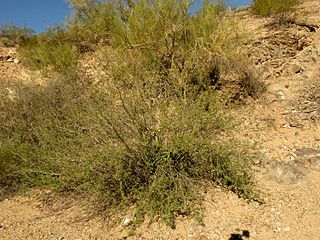
Coursetia is a genus of flowering plant in the pea family, Fabaceae. Members of the genus, commonly known as babybonnets, are shrubs and small trees native to the Southwestern United States, Mexico, the Caribbean, Central America, and South America as far south as Brazil and Peru. The genus is named for French botanist Georges Louis Marie Dumont de Courset (1746–1824).

Phyllota is a genus of flowering plants in the legume family, Fabaceae. It includes 11 species of shrubs native to temperate southeastern and southwestern Australia, in the states of New South Wales, Queensland, South Australia, Victoria, and Western Australia. They inhabit open woodland and forest, mallee woodland, and heathland, from coastal to semi-arid and montane areas.
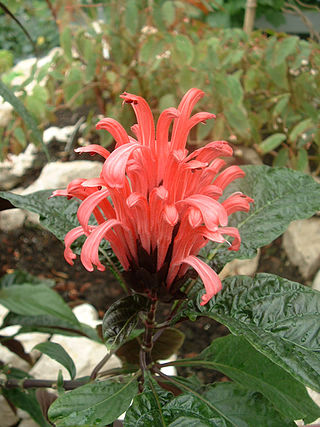
Justicia is a genus of flowering plants in the family Acanthaceae. It is the largest genus within the family, with over 900 accepted species. They are native to tropical to warm temperate regions of the Americas, India, and Africa. The genus serves as host to many butterfly species, such as Anartia fatima. Common names include water-willow and shrimp plant, the latter from the inflorescences, which resemble a shrimp in some species. The generic name honours Scottish horticulturist James Justice (1698–1763). They are closely related to Pachystachys.

Leucaena is a genus of flowering plants in the mimosoid clade of the subfamily Caesalpinioideae of the family Fabaceae. It contains about 24 species of trees and shrubs, which are commonly known as leadtrees. They are native to the Americas, ranging from Texas in the United States south to Peru. The generic name is derived from the Greek word λευκός (leukos), meaning "white," referring to the flowers.
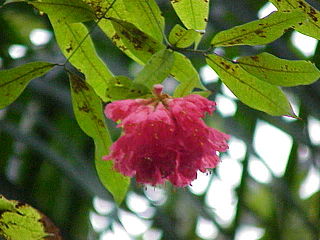
Brownea is a genus of flowering plants in the pea family (Fabaceae), subfamily Detarioideae. The genus includes about 22 species native to tropical regions of the Americas. The species are shrubs and trees growing to 20 m tall. Species range from Honduras through southern Central America and northern South America to Peru and northern Brazil, and to Trinidad and Tobago and the Windward Islands in the Caribbean. Species are typically understorey trees or shrubs in lowland tropical rain forest.
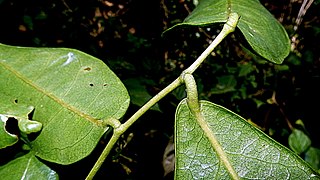
Poecilanthe is a genus of flowering plants in the family Fabaceae. It includes 9 species of trees and shrubs native to eastern, southern, and west-central Brazil, Bolivia, Paraguay, Uruguay, and northeastern Argentina. They grow in seasonally-dry tropical forest, woodland, thicket, and riverine forest.
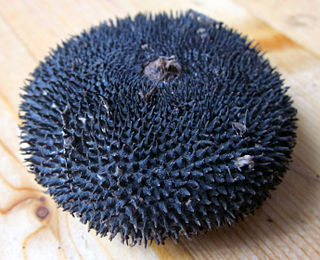
Apeiba is a genus of shrubs or trees in the family Malvaceae. It includes ten species native to the tropical Americas, ranging from northeastern Mexico to Bolivia and southeastern Brazil.

Beilschmiedia is a genus of trees and shrubs in family Lauraceae. Most of its species grow in tropical climates, but a few of them are native to temperate regions, and they are widespread in tropical Asia, Africa, Madagascar, Australia, New Zealand, North America, Central America, the Caribbean, and South America. The best-known species to gardeners in temperate areas are B. berteroana and B. miersii because of their frost tolerance. Seeds of B. bancroftii were used as a source of food by Australian Aborigines. Timbers of some species are very valuable.

Bebbia, common name sweetbush, is a genus of aromatic shrubs in the family Asteraceae. Its only species is Bebbia juncea.
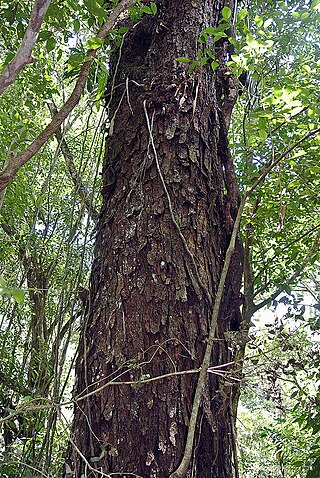
Parapiptadenia is a genus of flowering plants in the family Fabaceae. It includes six species of trees and shrubs native to eastern and southern Brazil, Bolivia, Paraguay, Uruguay, and northern Argentina. Typical habitats include tropical coastal and dune forest (restinga), woodland, scrub, and secondary growth forest. It belongs to the mimosoid clade of the subfamily Caesalpinioideae.
Pityrocarpa is a genus of flowering plants in the family Fabaceae. It includes seven species of shrubs and small trees native to the tropical Americas, including western and southeastern Mexico, Guatemala and El Salvador, Venezuela and Guyana, Bolivia, and eastern Brazil. Native habitats include tropical coastal rain forest, gallery forest, secondary forest, woodland, wooded grassland (Cerrado), and thorn scrub (Caatinga). It belongs to the mimosoid clade of the subfamily Caesalpinioideae.
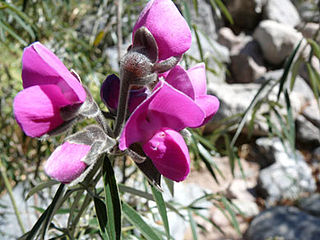
Collaea is a genus of flowering plants in the legume family, Fabaceae. It belongs to subfamily Faboideae and tribe Diocleae. It includes five species native to the southern tropical South America, ranging from Peru to northeastern Brazil and northeastern Argentina.

Dendrolobium is a genus of flowering plants in the legume family, Fabaceae. It belongs to the subfamily Faboideae. It includes 21 species of mostly trees and shrubs and rarely herbs. Species range from eastern Africa to Madagascar, India, Indochina, southern China, Malesia, Papuasia, northern and western Australia, and the southwestern Pacific. Typical habitats include seasonally-dry tropical forest and woodland, bamboo thickets, and grassland.

Harpalyce is a genus of flowering plants in the family Fabaceae. It belongs to the subfamily Faboideae. It includes 35 species of shrubs and small trees native to the tropical Americas. Their distribution is disjunct, ranging from Mexico to Nicaragua, Cuba, and northern to southeastern Brazil and Bolivia. Typical habitats include seasonally-dry tropical forest, warm-temperate humid forest, woodland, bushland and thicket, shrubland, and grassland. Most species are evergreen and flower during the dry season.

Salvia ballotiflora is a species of flowering plant in the mint family, Lamiaceae, that is native to Texas in the United States as well as northeastern and central Mexico. Common names include shrubby blue sage and mejorana.

The tribe Diocleae is one of the subdivisions of the plant family Fabaceae.
Pseudalbizzia is a genus of flowering plants in the pea family (Fabaceae). It includes 17 species which are native to the tropical Americas, from Mexico to northern Argentina.

Libidibia is a genus of flowering plants in the family Fabaceae. It includes seven species of trees and shrubs native to the tropical Americas, ranging from northern Mexico to northern Argentina. Typical habitats include seasonally-dry tropical forest and scrub, thorn forest, and savanna woodland. It belongs to the subfamily Caesalpinioideae.
Nanogalactia is a genus of flowering plants in the legume family (Fabaceae). It includes three species native to the tropical and subtropical Americas. The species have a disjunct distribution – Texas to southwestern Mexico, Colombia, and northeastern and west-central Brazil through Bolivia, Paraguay, and Uruguay to northern Argentina.
















